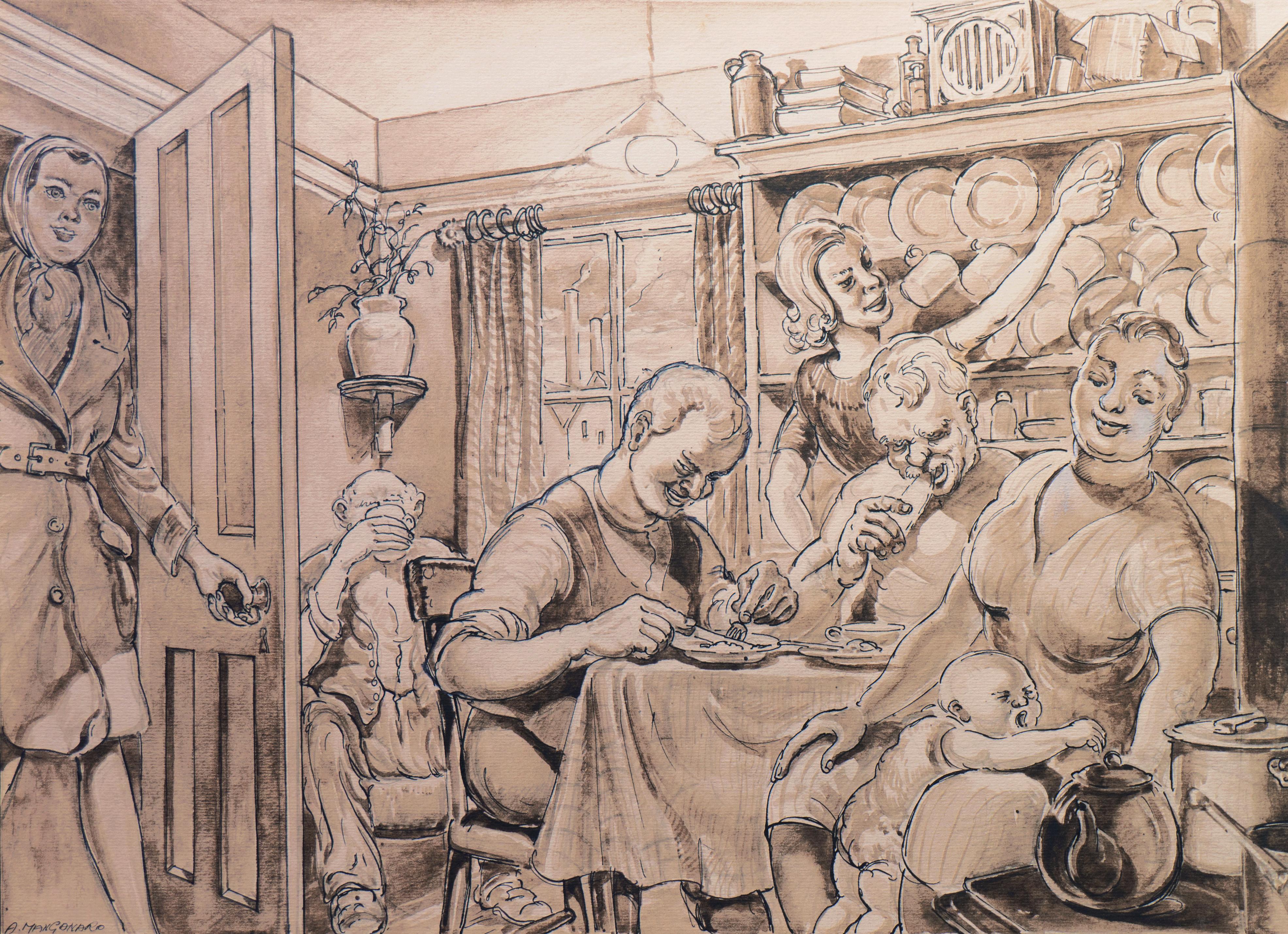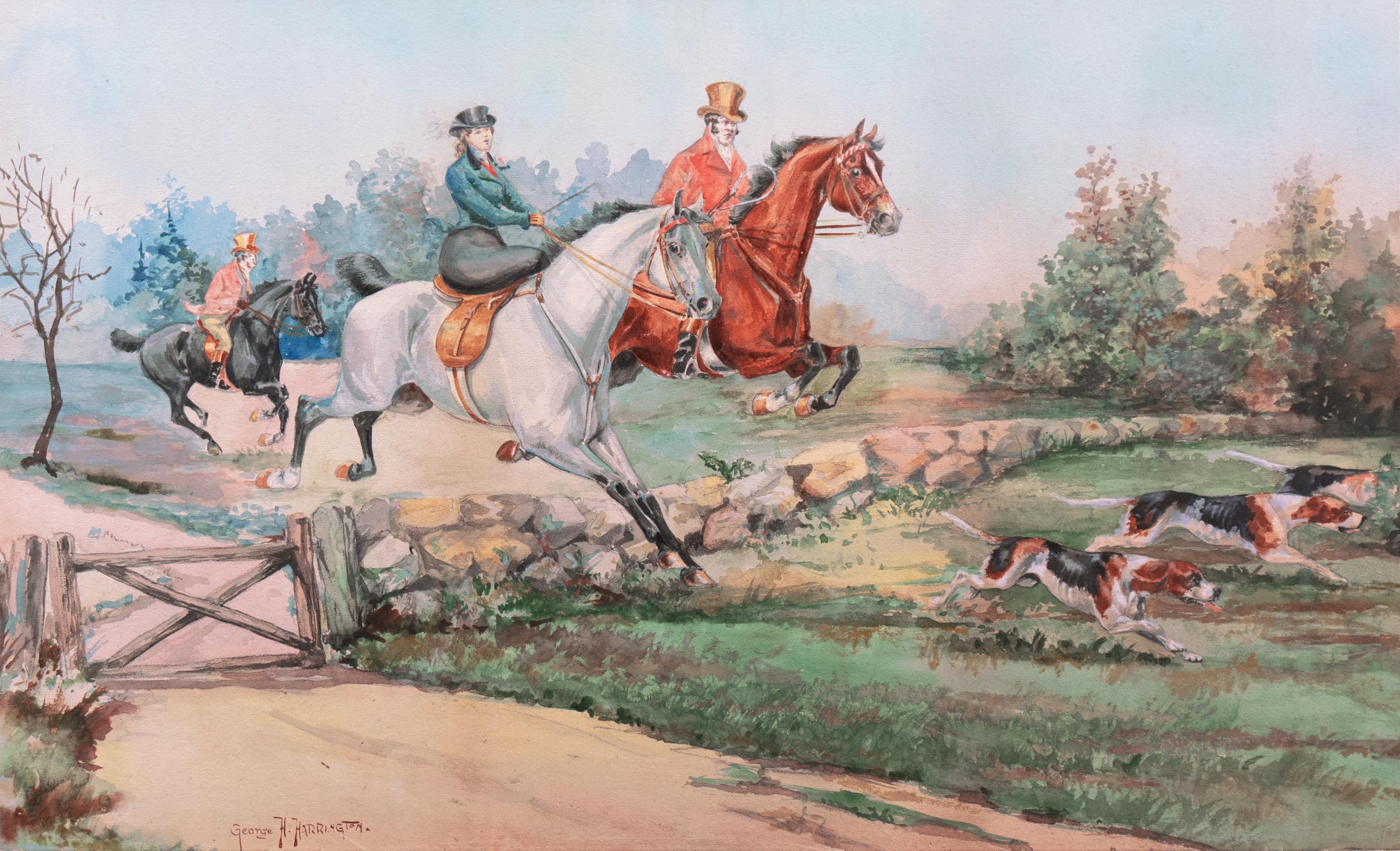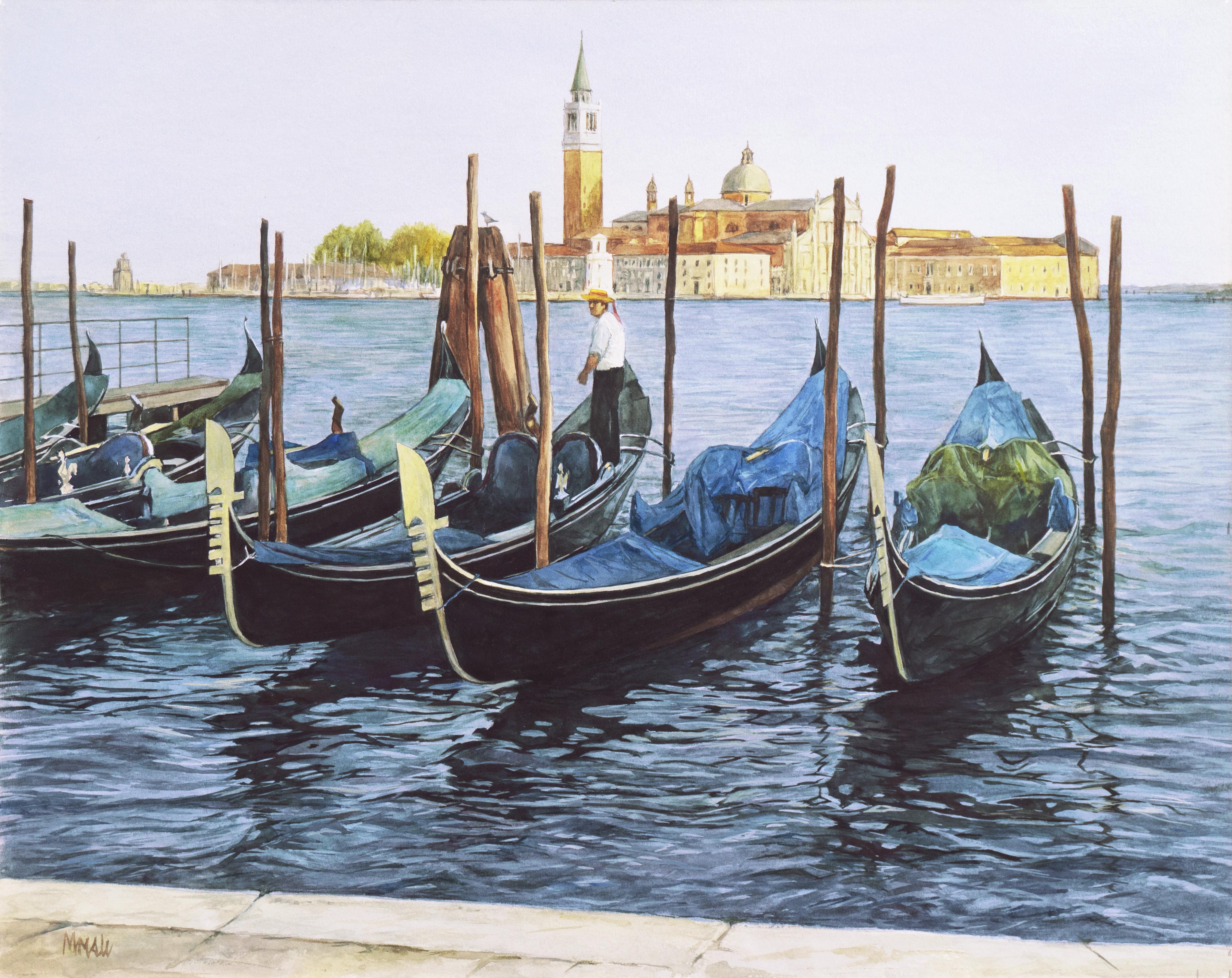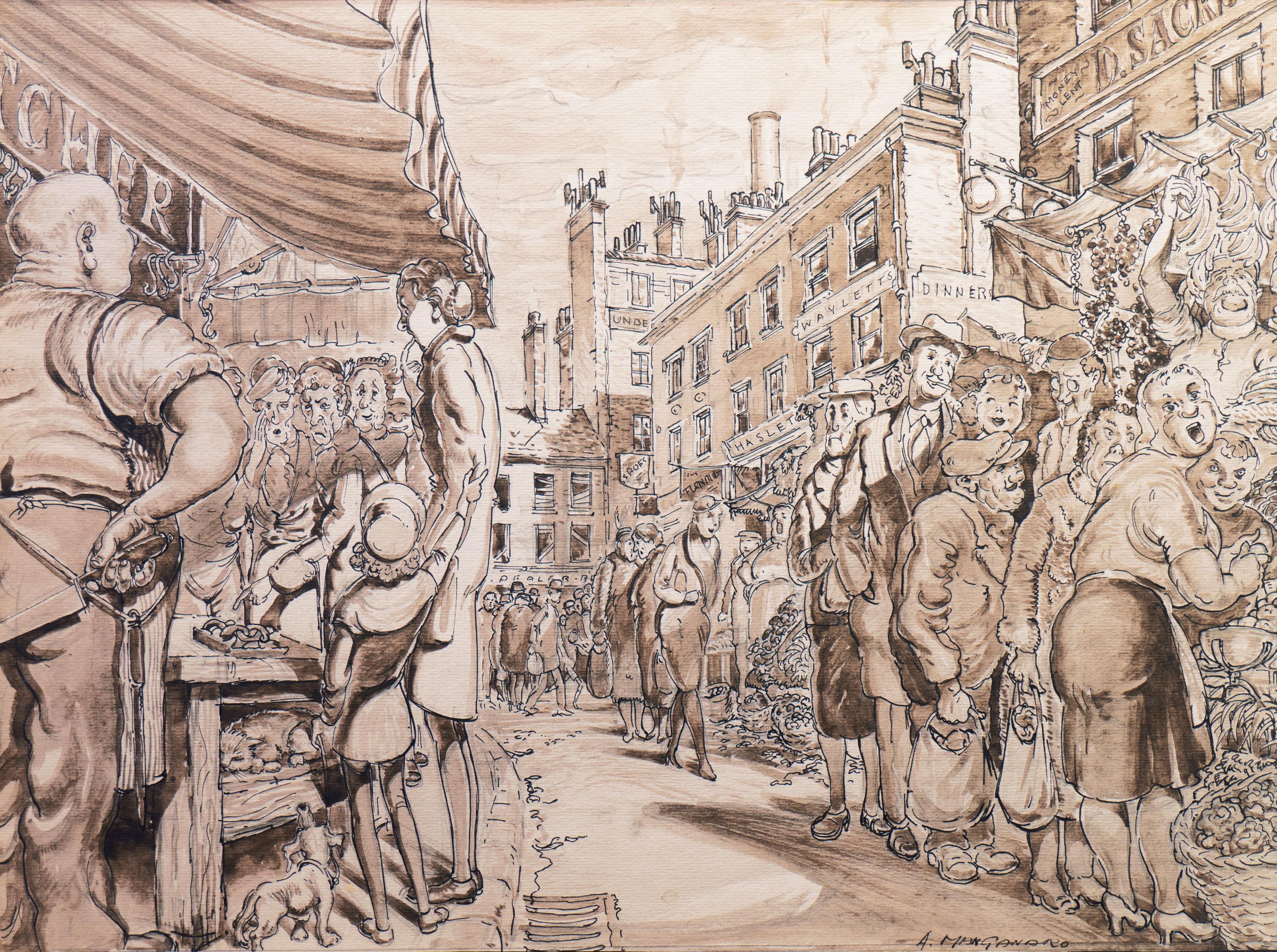Jacob EisenscherThe Village Market1947
1947
About the Item
- Creator:Jacob Eisenscher (1896 - 1980, Israeli)
- Creation Year:1947
- Dimensions:Height: 27.13 in (68.92 cm)Width: 22.25 in (56.52 cm)Depth: 2 in (5.08 cm)
- Medium:
- Movement & Style:
- Period:
- Condition:Excellent color, no tears or rips. No visible signs of wear or discoloration.
- Gallery Location:Missouri, MO
- Reference Number:1stDibs: LU74734902042
Jacob Eisenscher
Jacob Eisenscher studied at the Academy of Fine Arts in Vienna and after spending five years in Paris, immigrated to Israel in 1935. Eisenscher taught at the Bezalel in Jerusalem for 15 years and is known for his paintings of that city and surrounding villages, landscapes and coasts. Eisenscher’s style is largely characterized by the geometric trend of the Constructivist School. Having numerous one-man shows in Israeli museums and galleries, Eisenscher was awarded the Dizengoff Prize in 1947, the Sao Paolo Biennale Prize in 1953 and the Haifa Municipality Prize in 1958.
- ShippingRetrieving quote...Ships From: Missouri, MO
- Return PolicyA return for this item may be initiated within 2 days of delivery.
- The FlirtationBy Allesandro BattagliaLocated in Missouri, MOAllesandro Battaglia (1870-1940, Italian) "The Flirtation" 1906 Watercolor on Paper Signed "A. Battaglia, Roma 1906" Site Size: 30 x 20 inches Framed Size: approx 41 x 33 inches Son of Clelia Bompiani and Ercole Battaglia, he was trained by his grandfather Roberto Bompiani...Category
Early 1900s Realist Figurative Drawings and Watercolors
MaterialsArchival Paper, Watercolor
- Carriage Ride in the ParkBy Constantin Ernest Adolphe Hyacinthe GuysLocated in Missouri, MOConstantin Guys (1802-1892) "Carriage Ride in the Park" c. 1860s Ink and Wash on Paper Original Labels Verso Site Size: approx. 8 x 11.5 inches Framed S...Category
1860s Realist Figurative Drawings and Watercolors
MaterialsInk, Paper, Watercolor
- Caesar ProvokedLocated in Missouri, MOAlessandro Pigna (Italian, 1862-1919) "Caesar Provoked" c. 1890 Watercolor Signed Lower Left "APigna" Site Size: approx. 18 x 28.5 inches Framed Size: approx. 24 x 34.5 inches Ales...Category
Late 19th Century Realist Figurative Drawings and Watercolors
MaterialsWatercolor
- Season's Greetings 1960 (Brave on Horseback)By Olaf WieghorstLocated in Missouri, MOOlaf Wieghorst (American, 1899-1988) "Season's Greetings" (Brave on Horseback) 1960 Watercolor/Gouache on Paper Initialed and Monogramed and Dated Dedicated: "To Rosalie & Jack, Season's Greetings, Mae & Olaf Xmas 1960" Site Size: 12 x 9 inches Framed Size: approx. 22.5 x 18.5 inches Born in Viborg, Denmark, Olaf Wieghorst was a child acrobatic performer from the age of nine when he began appearances at Tivoli Theater in Copenhagen and later toured Europe. He also learned horseback riding working on a stock farm, and horses became a major focus of his admiration and later his painting. In 1918, he arrived in the United States, having worked as a cabin boy on a steamer. He served in the 5th U.S. Cavalry on the Mexican border in the days of Pancho Villa...Category
1960s American Realist Figurative Drawings and Watercolors
MaterialsWatercolor, Paper, Gouache
- The Necklace and the PotBy Gisella LoefflerLocated in Missouri, MOGisella Loeffler "The Necklace and the Pot" c. 1919 Gouache on Paper Initialed Lower Left Framed Size: approx 15 x 15 inches In a village filled with colorful characters, few Taos artists were as colorful as Gisella Loeffler [1900-1977]. From her handmade Austrian clothing and hand-painted furniture to whimsical paintings and letters written in multicolored crayon, joyful color defined the artist, who early on chose to use simply Gisella as her professional name and was known as such to everyone in Taos. In spite of her fame there—the Taos News once labeled her a Taos legend—Gisella is rarely included in scholarly discussions of the Taos Art Colony. This oversight is likely due to the naive quality of her work, in which children or childlike adults inhabit a simple, brightly colored world filled with happiness. The macabre, the sad, the tortured, the offensive—all have no place in Gisella’s paintings. Her naive style of work looks very different from that of the better-known early Taos artists. Yet both Gisella’s artwork and her interesting life command attention. Born in Austria, Gisella came to the United States with her family in 1908, settling in St. Louis, MO. After studying art at Washington University in St. Louis, she became a prominent member of the local art community, joining the St. Louis Art Guild as well as the Boston Society of Arts and Crafts. In addition to creating posters for the St. Louis Post Dispatch, Gisella won prizes from the Artists Guild of the Author’s League of America in 1919 and 1920 and from the Kansas City Art Institute in 1923. She also began working in textiles, including batik, to which she would return later in her career. In the early 1920s Gisella married writer and music critic Edgar Lacher. A difficult character, Lacher may have chafed under Gisella’s success, for the couple divorced in the 1930s. Having seen a local exhibition of paintings by Taos artists Oscar Berninghaus (who was from St. Louis) and Ernest Blumenschein, Gisella felt drawn to Taos, which reminded her of the villages of her native Austria. In 1933 the single mother with two daughters, Undine and Aithra, moved to Taos, where she lived off and on for the rest of her life. She traveled frequently, spending extended periods in Mexico, South America, and California, but always returned to New Mexico. Gisella initially applied an Austro-Hungarian folk-art style to the Indian and Hispanic subjects that she found in New Mexico. In her early work she covered her surfaces with decorative floral and faunal motifs, and her images were flat with no attempt at rendering traditional one-point perspective. Eventually, though, Gisella developed her own style, often using children or childlike figures as subjects. Still, the influence of her native country’s folk art remained evident in her New Mexican, Mexican, and South American images. In 1938 Gisella moved briefly to Los Griegos, north of Albuquerque, to be closer to medical facilities for her eldest daughter, who was suffering from rheumatic fever. Two years later, she moved to California to participate in the war effort, painting camouflage and decals on airplanes for Lockheed. In California, Gisella broadened her range of artistic pursuits. She taught art privately, created illustrations for Scripts Magazine, and did interior design for private homes. She also designed greeting cards, a practice she continued after her return to New Mexico, where she created a series of Christmas cards. Gisella began illustrating children’s books in 1941 when she collaborated on Franzi and Gizi with author Margery Bianco. Eventually she wrote and illustrated her own book, El Ekeko, in 1964. She also designed ceramics—her Happy Time Dinnerware, marketed by Poppy Trail...Category
1910s Modern Figurative Drawings and Watercolors
MaterialsGouache
- Three GirlsBy Gisella LoefflerLocated in Missouri, MOGisella Loeffler "Three Girlsl" c. 1919 Gouache on Paper Initialed Lower Left Framed Size: approx 19 x 13 inches In a village filled with colorful characters, few Taos artists were as colorful as Gisella Loeffler [1900-1977]. From her handmade Austrian clothing and hand-painted furniture to whimsical paintings and letters written in multicolored crayon, joyful color defined the artist, who early on chose to use simply Gisella as her professional name and was known as such to everyone in Taos. In spite of her fame there—the Taos News once labeled her a Taos legend—Gisella is rarely included in scholarly discussions of the Taos Art Colony. This oversight is likely due to the naive quality of her work, in which children or childlike adults inhabit a simple, brightly colored world filled with happiness. The macabre, the sad, the tortured, the offensive—all have no place in Gisella’s paintings. Her naive style of work looks very different from that of the better-known early Taos artists. Yet both Gisella’s artwork and her interesting life command attention. Born in Austria, Gisella came to the United States with her family in 1908, settling in St. Louis, MO. After studying art at Washington University in St. Louis, she became a prominent member of the local art community, joining the St. Louis Art Guild as well as the Boston Society of Arts and Crafts. In addition to creating posters for the St. Louis Post Dispatch, Gisella won prizes from the Artists Guild of the Author’s League of America in 1919 and 1920 and from the Kansas City Art Institute in 1923. She also began working in textiles, including batik, to which she would return later in her career. In the early 1920s Gisella married writer and music critic Edgar Lacher. A difficult character, Lacher may have chafed under Gisella’s success, for the couple divorced in the 1930s. Having seen a local exhibition of paintings by Taos artists Oscar Berninghaus (who was from St. Louis) and Ernest Blumenschein, Gisella felt drawn to Taos, which reminded her of the villages of her native Austria. In 1933 the single mother with two daughters, Undine and Aithra, moved to Taos, where she lived off and on for the rest of her life. She traveled frequently, spending extended periods in Mexico, South America, and California, but always returned to New Mexico. Gisella initially applied an Austro-Hungarian folk-art style to the Indian and Hispanic subjects that she found in New Mexico. In her early work she covered her surfaces with decorative floral and faunal motifs, and her images were flat with no attempt at rendering traditional one-point perspective. Eventually, though, Gisella developed her own style, often using children or childlike figures as subjects. Still, the influence of her native country’s folk art remained evident in her New Mexican, Mexican, and South American images. In 1938 Gisella moved briefly to Los Griegos, north of Albuquerque, to be closer to medical facilities for her eldest daughter, who was suffering from rheumatic fever. Two years later, she moved to California to participate in the war effort, painting camouflage and decals on airplanes for Lockheed. In California, Gisella broadened her range of artistic pursuits. She taught art privately, created illustrations for Scripts Magazine, and did interior design for private homes. She also designed greeting cards, a practice she continued after her return to New Mexico, where she created a series of Christmas cards. Gisella began illustrating children’s books in 1941 when she collaborated on Franzi and Gizi with author Margery Bianco. Eventually she wrote and illustrated her own book, El Ekeko, in 1964. She also designed ceramics—her Happy Time Dinnerware, marketed by Poppy Trail...Category
1910s Modern Figurative Drawings and Watercolors
MaterialsGouache
- Set of Three Gouache & Watercolour Paintings of Tribal Objects on Handmade PaperBy La Roche LaffitteLocated in Cotignac, FRA set of three framed watercolour and gouache studies on handmade paper applied to Vélin d'Arches of tribal objects by French artist La Roche Laffi...Category
Late 20th Century Realist Figurative Drawings and Watercolors
MaterialsWatercolor, Gouache, Handmade Paper
- 'The Working Class Enjoying a Meal', Satire of Capitalism, ProletarianBy Antonio ManganaroLocated in Santa Cruz, CASigned lower left, 'A. Manganaro' for 'Antonio Manganaro (Italian, 20th Century), and titled lower center, 'Ability of the Working Classes to Enjoy Meals Under Humble Surroundings'. ...Category
Mid-20th Century Realist Figurative Drawings and Watercolors
MaterialsPaper, Ink, Gouache, Pen, Graphite
- 'Steeplechase', Boston, Massachusetts, National Academy of Design, Beagle, HorseLocated in Santa Cruz, CASigned lower left, 'George H Harrington' (American, 1833-1911) and painted circa 1900. Born in Springfield, Massachusetts, George Harrington is recognized for his turn-of-the-century works reflecting American life before the industrial age, particularly for equestrian scenes that include polo matches, carriage rides, and horses in pastoral landscapes. After a successful career in business, Harrington studied art and became a successful landscape painter. He exhibited widely including at the National Academy of Design, the Pennsylvania Academy of Fine Arts, the Boston Athenaeum and at the Boston Art Club, of which he was a member. Reference: Who Was Who in American Art 1564-1975: 400 Years of Artists in America, Peter Hastings Falk, Sound View Press 1999, Vol. 2, page 1465; A Biographical Index of American Artists, Ralph Clifton Smith...Category
Early 1900s Realist Animal Drawings and Watercolors
MaterialsWatercolor, Paper, Gouache
- 'London to Brighton Coach', Massachusetts, National Academy of Design, HorsesLocated in Santa Cruz, CASigned lower right, 'George H Harrington' (American, 1833-1911) and painted circa 1900. A substantial and animated coaching scene enlivened by the artist's acute and humorous observation of character and fine equestrian painting. Born in Springfield, Massachusetts, George Harrington is known for his, often humorous, anecdotes of American life in the pre-industrial age. His subjects included polo matches, carriage rides and coaching scenes, and pastoral landscapes. After a professional career in business, Harrington studied art and subsequently became a successful landscape and equestrian painter. He exhibited widely and with success including at the National Academy of Design (1888), the Pennsylvania Academy of Fine Arts, the Boston Athenaeum and at the Boston Art Club of which he was a member. Reference: Who Was Who in American Art 1564-1975: 400 Years of Artists in America, Peter Hastings Falk, Sound View Press 1999, Vol. 2, page 1465; A Biographical Index of American Artists, Ralph Clifton Smith...Category
Early 1900s Realist Animal Drawings and Watercolors
MaterialsWatercolor, Paper, Gouache
- 'Gondolas, San Giorgio Maggiore', Venetian Vedute, Venice, Ruskin School of ArtBy Robert MoesleLocated in Santa Cruz, CASigned lower left, 'Moesle' for Robert Moesle (American, b. 1932); additionally signed verso, titled 'Waiting Gondolier' and dated March 1998. A substantial and finely detailed wat...Category
1970s Realist Landscape Drawings and Watercolors
MaterialsGouache, Paper
- 'The Enduring Attractions of the Open Market', Capitalism SatireBy Antonio ManganaroLocated in Santa Cruz, CASigned lower right, 'A. Manganaro' for 'Antonio Manganaro (Italian, 20th Century), and titled lower center, 'The Enduring Attractions of the Open Market'. Matted Dimensions: 16 x 20Category
Mid-20th Century Realist Figurative Drawings and Watercolors
MaterialsGouache, Pen, Graphite, Paper, Ink






